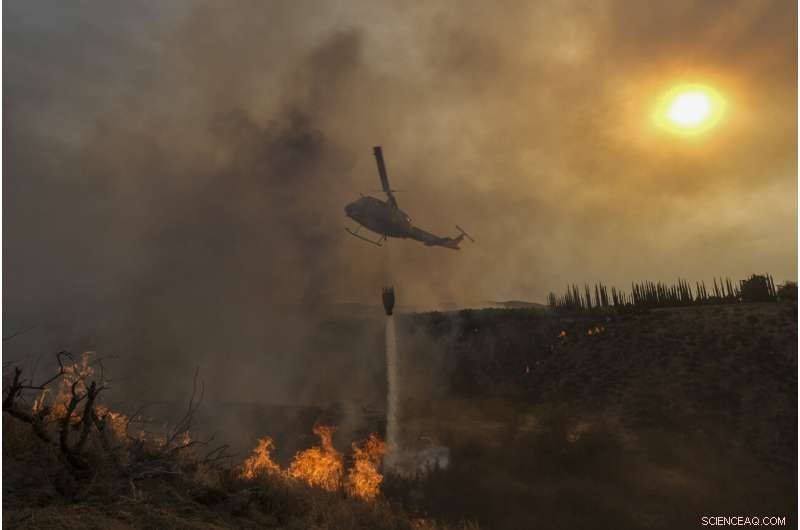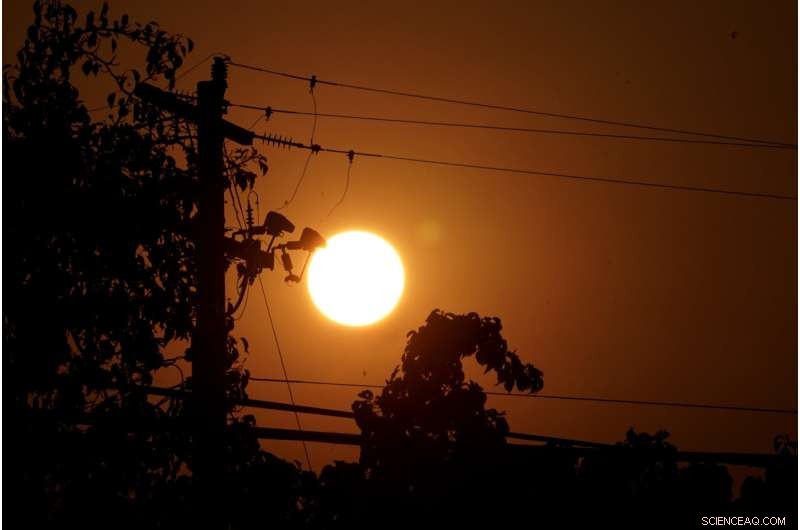
Un helicóptero arroja agua sobre el incendio de Fairview que arde en una colina el jueves 8 de septiembre de 2022, cerca de Hemet, California. Los científicos dicen que el calentamiento del planeta provocará olas de calor más calientes, más largas y plagadas de incendios forestales. Crédito:Foto AP/Ringo H.W. Chiu, Archivo
Los californianos trataron de capear los extremos de un clima cambiante el viernes, ya que una ola de calor que ha ayudado a alimentar incendios forestales mortales tuvo al estado al borde de los apagones por décimo día consecutivo, mientras que una tormenta tropical tocó tierra con la promesa de temperaturas más frescas pero También posibles inundaciones.
El cambio abrupto en las condiciones incluso azotó a los adictos al clima.
"Esta es quizás la semana climática singularmente más inusual y extrema en bastante tiempo en California, y eso es decir algo. ¡Uf!", escribió Daniel Swain, científico climático de la Universidad de California, Los Ángeles, en su blog del clima occidental.
Si bien las lluvias pueden ser bienvenidas en el estado plagado de sequías y brindarán alivio con temperaturas más normales, se pronostica que las inundaciones y las olas de calor más brutales se convertirán en elementos habituales a medida que el cambio climático calienta el planeta y los desastres relacionados con el clima se vuelven más extremos.
“Veremos que estas olas de calor se vuelven cada vez más calientes, más y más largas, más plagadas de incendios forestales”, dijo Jonathan Overpeck, decano de la Escuela de Medio Ambiente y Sostenibilidad de la Universidad de Michigan. "Las probabilidades de precipitaciones realmente intensas están aumentando. Por eso nos preocupan las inundaciones asociadas con este huracán remanente".
California es solo la última víctima en un año de olas de calor a veces mortales que comenzaron en Pakistán e India esta primavera y barrieron partes del hemisferio norte, incluidas China, Europa y otras áreas de los EE. UU.
El cambio climático también exacerbó las sequías, secó los ríos, hizo que los incendios forestales fueran más intensos y, por el contrario, provocó inundaciones masivas en todo el mundo a medida que la humedad que se evapora de la tierra y el agua se retiene en la atmósfera y luego se vuelve a depositar por las lluvias intensas.
Los científicos son reacios a atribuir cualquier evento meteorológico específico, como el huracán Kay, ahora degradado a tormenta tropical a medida que se dirige a California, al calentamiento global. Pero dicen que las olas de calor son exactamente el tipo de cambio que se volverá más común.
El llamado domo de calor que cocinó a California quedó atrapado en una región excepcional de alta presión sobre Groenlandia, de todos los lugares, que esencialmente creó un embotellamiento meteorológico, dijo Paul Ullrich, profesor de modelado climático regional en la Universidad de California, Davis. Eso evitó que se moviera el sistema de alta presión que forzaba el aire caliente sobre California.
Una marquesina afuera de un antiguo teatro en el barrio chino de Los Ángeles decía:"Satanás llamó. Quiere recuperar su clima".
Las temperaturas alcanzaron un máximo histórico en Sacramento de 116 grados (46,7 C) el martes. Muchos otros lugares alcanzaron máximos históricos en septiembre e incluso más marcaron máximos diarios.
El calor que tiñó de rojo oscuro los mapas meteorológicos durante más de una semana en California es solo un anticipo de las próximas atracciones.
Sacramento, la capital del estado, tiene alrededor de 10 días de "calor extremo" al año y eso se duplicará nuevamente a mediados de siglo. En la década de 1970, la ciudad tenía cinco, dijo Ullrich.

El amanecer se ve entre las líneas eléctricas en Sacramento, California, el jueves 8 de septiembre de 2022. El calor récord que ha llevado a la red eléctrica del estado al borde de los cortes de energía durante más de una semana casi ha terminado, pero es un señal de lo que vendrá. Credit:AP Photo/Rich Pedroncelli, File
"That's pretty much going to be the story for much of the Central Valley and much of Southern California," Ullrich said. "This kind of exponential growth in the number of extreme heat days. If you tie those all together, then you end up with heat waves like we've experienced."
For nine days through Thursday, the vast energy network that includes power plants, solar farms and a web of transmission lines strained under record-setting demand driven by air conditioners.
"If we're going to build a statue to anybody in the West, it will be a Willis Carrier," said Bill Patzert, retired climatologist at NASA's Jet Propulsion Laboratory, about the inventor of the air conditioner. "Really large areas of Southern California would essentially be unlivable without air conditioning."
Air conditioning puts the biggest strain on power sources during a heat wave and operators of the electrical grid called for conservation and warned of the threat of power outages as usage hit an all-time high Tuesday, surpassing a record set in 2006.
The state may have averted a repeat of rolling outages two summers ago by sending a first-ever text alert that blared on 27 million phones urging Californians to "take action" and turn off nonessential power. Enough turned up thermostats, turned off lights or pulled the plug on appliances to avoid power cuts, though thousands of customers did lose power at various times for other reasons.
The West is in the throes of a 23-year megadrought that has nearly drained reservoirs and put water supplies in jeopardy. That, in turn, led to a sharp decrease in hydropower that California relies on when power is in peak demand.
"Part of the country that's getting hit worst is the Southwest and Western United States," Overpeck said. "It is a global poster child for the climate crisis. And this year, this summer, it's really the Northern Hemisphere has been just an unusually hot and wildfire-plagued hemisphere."
The extreme heat helped fuel deadly wildfires at both ends of the state as flames fed on grass, brush and timber already "preconditioned to burn" by drought and then pushed over the edge by the heatwave, Overpeck said.
Firefighters struggled to control major wildfires in Southern California and the Sierra Nevada that exploded in growth, forced thousands to evacuate and produced smoke that could interfere with solar power and further hamper electricity supplies.
Two people were killed in the fire that erupted last Friday in the Northern California community of Weed at the base of Mount Shasta. Two others died trying to flee in their car from a fire in Riverside County that was threatening 18,000 homes.
What remains of the hurricane is expected to bring heavy rains and even flash floods to Southern California from Friday night through Saturday. Strong winds could initially make it difficult and dangerous for firefighters trying to corral blazes, Patzert said.
Heavy downpours could also unleash mudslides on mountainsides charred by recent fires. While several inches of rain could fall, much of it will run off the arid landscape and will not make a dent in the drought.
"It comes at you like a firehose and you're trying to fill your champagne glass," Patzert said. "Everybody's sort of excited, but on Saturday night a lot of people will be saying, 'Yeah, we could have done without that.'" + Explora más
© 2022 Prensa Asociada. Reservados todos los derechos. Este material no se puede publicar, transmitir, reescribir ni redistribuir sin permiso.